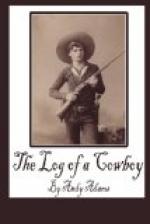Before we had finished supper, Honeyman had rehooked the mules to the wagon, while the remuda was at hand to follow. Before we left the wagon, a full moon was rising on the eastern horizon, and as we were starting out Flood gave us these general directions: “I’m going to take the lead with the cook’s lantern, and one of you rear men take the new bull’s-eye. We’ll throw the herd on the trail; and between the lead and rear light, you swing men want to ride well outside, and you point men want to hold the lead cattle so the rear will never be more than a half a mile behind. I’ll admit that this is somewhat of an experiment with me, but I don’t see any good reason why she won’t work. After the moon gets another hour high we can see a quarter of a mile, and the cattle are so well trail broke they’ll never try to scatter. If it works all right, we’ll never bed them short of midnight, and that will put us ten miles farther. Let’s ride, lads.”
By the time the herd was eased back on the trail, our evening camp-fire had been passed, while the cattle led out as if walking on a wager. After the first mile on the trail, the men on the point were compelled to ride in the lead if we were to hold them within the desired half mile. The men on the other side, or the swing, were gradually widening, until the herd must have reached fully a mile in length; yet we swing riders were never out of sight of each other, and it would have been impossible for any cattle to leave the herd unnoticed. In that moonlight the trail was as plain as day, and after an hour, Flood turned his lantern over to one of the point men, and rode back around the herd to the rear. From my position that first night near the middle of the swing, the lanterns both rear and forward being always in sight, I was as much at sea as any one as to the length of the herd, knowing the deceitfulness of distance of campfires and other lights by night. The foreman appealed to me as he rode down the column, to know the length of the herd, but I could give him no more than a simple guess. I could assure him, however, that the cattle had made no effort to drop out and leave the trail. But a short time after he passed me I noticed a horseman galloping up the column on the opposite side of the herd, and knew it must be the foreman. Within a short time, some one in the lead wig-wagged his lantern; it was answered by the light in the rear, and the next minute the old rear song,—
“Ip-e-la-ago,
go ’long little doggie,
You ’ll make a
beef-steer by-and-by,”—
reached us riders in the swing, and we knew the rear guard of cattle was being pushed forward. The distance between the swing men gradually narrowed in our lead, from which we could tell the leaders were being held in, until several times cattle grazed out from the herd, due to the checking in front. At this juncture Flood galloped around the herd a second time, and as he passed us riding along our side, I appealed to him to let them go in front, as it now required constant riding to keep the cattle from leaving the trail to graze. When he passed up the opposite side, I could distinctly hear the men on that flank making a similar appeal, and shortly afterwards the herd loosened out and we struck our old gait for several hours.




